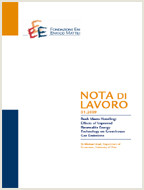Breaking the Impasse in International Climate Negotiations: A New Direction for Currently Flawed Negotiations and a Roadmap for China to 2050

11.06.2011
ZhongXiang Zhang
Q42, Q43, Q48, Q52, Q53, Q54, Q58
Carbon Intensity, Post-Copenhagen Climate Change Negotiations, Climate Commitments, China
Climate Change and Sustainable Development
Carlo Carraro
China’s unilateral pledge to cut its carbon intensity by 40-45 percent by 2020 relative to its 2005 levels raises both the stringency issue, and given that China’s pledge is in the form of carbon intensity, reliability issues concerning China’s statistics on energy and GDP. Moreover, as long as China’s commitments differ in form from those of other major greenhouse gas emitters, China is constantly confronted with both criticism on its carbon intensity commitment being less stringent and the threats of trade measures. In response to these concerns and to put China in a positive position, this paper will map out a realistic roadmap for China’s specific climate commitments towards 2050, with its main distinguishing features including China taking on absolute emission caps around 2030 and the three transitional periods of increasing climate obligations before that. With current international climate negotiations flawed with a focus on commitments on the targeted date of 2020 that does not accommodate well the world’s two largest greenhouse gas emitters, the paper suggests a new direction to break the current impasse in international climate negotiations.
